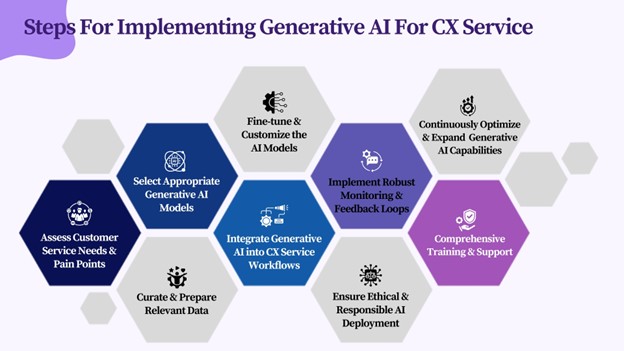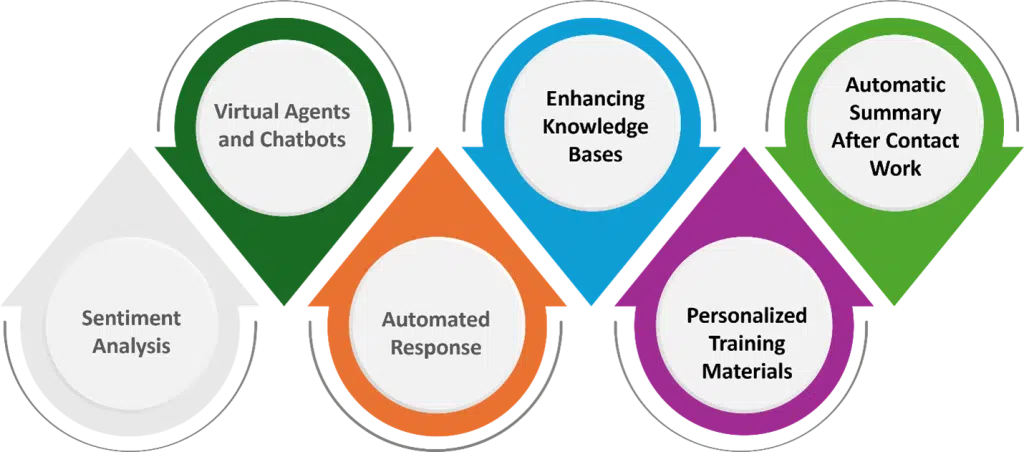In the ever-evolving digital landscape, the Customer Service and Support (CSS) industry is also rapidly transforming to enhance the Customer Experience (CX) and services. Customer service has undergone major changes just in the last few years and leveraging innovative technologies like Generative AI (Gen AI) is leading the charge now. Wonder why enterprises are investing in next-generation technologies like Gen AI? Enterprises should be able to address the fluctuating user demands and expectations. Therefore, it is necessary to integrate Gen AI into customer services. Gen AI is a suitable choice for every enterprise to confront the challenges involved in the CSS workflow.
As businesses strive to stay ahead in an increasingly competitive landscape, Gartner predicts that by 2025, 80% of customer service and support organizations will be applying generative AI technology in some form to improve agent productivity and customer experience. Let us explore in this blog how accurately enterprises should place and implement this innovation.
Gen AI is a subset of Artificial Intelligence (AI) which utilizes Large Language Models (LLMs) to generate better quality content including text, audio, images, and code. Generative AI for customer service is now capable of understanding and responding to customer inquiries with remarkable accuracy and nuance, drawing from a vast knowledge base to provide tailored solutions.
Generative AI for customer service can:
This has enabled customer service teams to make their workflows more efficient, respond faster, and provide stellar customer experience. It will become a crucial factor in providing exceptional service, building stronger customer relationships, and driving long-term loyalty and satisfaction.
To achieve these benefits, though, you need to prepare for implementing generative AI for your business’s customer service function. Let us now delve into the key steps to implement Gen AI in Customer Service.
Here are some key steps to follow for implementing generative AI for customer service as shown in the image below:

| Steps | Description |
| Assess Customer Needs | Analyze current processes, challenges, and areas for improvement to identify use cases where generative AI can enhance customer experience and efficiency. |
| Select The Right AI Models | Evaluate your use cases/requirements and compare different generative AI models (e.g., GPT-3, Transformer, DALL-E), Look at language understanding, response generation, and task-specific capabilities when choosing. |
| Curate and Prepare Data | Gather and clean customer service data, including past conversations, knowledge base, and product information. Ensure data quality, consistency, and relevance for model training. |
| Fine-tune and customize | Adapt pre-trained generative AI models to your customer service domain and requirements. Incorporate domain-specific knowledge, policies, and brand guidelines. |
| Integrate into Workflows | Integrate generative AI capabilities into existing customer service platforms and channels (e.g., chatbots, virtual agents, email). Ensure smooth and natural interactions. |
| Monitor and Collect Feedback | Continuously monitor performance and quality of generative AI interactions. Collect customer feedback to refine and improve the AI models and responses. |
| Provide Training and Support | Train customer service agents on the capabilities and limitations of the generative AI system. Develop communication strategies to manage customer expectations. |
| Optimize and expand | Explore opportunities to update and expand the use of generative AI to meet evolving customer needs. |
By following these steps, you can successfully implement generative AI in your customer service operations, and reap the following benefits:
To know more details on integrating AI into customer experience, visit our blog AI in CX Engineering. To reap benefits of Gen AI, it is important to follow some best practices for successfully implementing Generative AI in customer services.
Integrating generative AI in customer service can revolutionize interactions and support. By following best practices, you can enhance efficiency, improve response times, and deliver personalized experiences.
Next, let’s look at some use cases where generative AI for customer service can create a significant impact in customer experience.

Generative AI can significantly reduce the time customer service agents spend on after-contact work. By automating documentation and data entry, AI streamlines workflows and allows agents to focus on more valuable tasks.
After-contact Work:
| Aspect | Description |
| Documenting Interactions | Agents record details of customer interactions to maintain accurate records and ensure continuity in service. |
| Updating Customer Data | Ensuring customer profiles are current and reflect recent interactions for personalized service and efficient follow-ups. |
| Tracking and Reporting | Entering data into systems for tracking performance metrics and generating reports to analyze trends and improve service strategies. |
Generative AI Systems:
| Aspect | Description |
| Efficient Information Analysis | AI systems can process large volumes of data swiftly, extracting key insights and reducing the manual effort required for analysis. |
| Automated Summarization | Summarizes interactions into concise reports, highlighting essential details for quick review and decision-making. |
Adaptability of AI Summarization Tools:
| Aspect | Description |
| Customization Options | Tailoring summaries to match organizational communication styles and operational requirements for seamless integration. |
| Focused Insights | Highlighting critical information and actionable insights tailored to support decision-making and strategic planning efforts. |
Generative AI’s sentiment analysis provides deeper insights into customer emotions, enabling more personalized and effective responses. By analyzing real-time interactions, AI enhances customer service and informs strategic business decisions.
Harnessing AI’s Capabilities:
| Aspect | Description |
| Deeper Emotional Insights | AI’s advanced language models help understand the underlying emotional states of customers. |
| Effective Response | Enables customer service agents to respond more effectively by personalizing their approach based on customer emotions. |
Generative AI Models:
| Aspect | Description |
| Data-Driven Training | Generative AI models are trained on extensive data to understand the nuances and complexities of human language. |
| Real-time Sentiment Analysis | These models can analyze tone, word choice, and overall sentiment during interactions, providing valuable feedback to service teams. |
Benefits of AI-based Sentiment Analysis:
| Aspect | Description |
| Informed Business Decisions | Provides insights for product development, marketing strategies, and customer retention initiatives based on emotional patterns. |
| Enhanced Customer Relationships | Understanding customer emotions helps make informed choices that resonate with the audience, fostering loyalty and stronger relationships. |
| Strategic Implementation | Allows for exceptional customer service and personalized experiences, which can be a strategic business advantage. |
Generative AI has revolutionized virtual agents and chatbots, enabling them to engage in natural, human-like conversations. These advancements enhance user experience and provide valuable insights for better decision-making.
Generative AI Transforming Virtual Agents and Chatbots:
| Aspect | Description |
| Human-like Conversations | Gen-AI based virtual agents and chatbots can engage in natural, human-like interactions, personalizing the customer experience |
| Powerful Engagement | With the ability to handle queries ranging from the basic to complex problem-solving tasks, these AI-powered tools can deeply engage customers. |
Highly Responsive and Adaptive Virtual Assistants:
| Aspect | Description |
| Context Understanding | AI-enabled virtual agents understand context and interpret nuanced language, providing tailored responses. |
| Personalized Interactions | They deliver responses that feel genuine and personalized, enhancing customer satisfaction. |
Enhancing User Experience with Dynamic Conversations:
| Aspect | Description |
| Dynamic Text Generation | Chatbots generate text that flows freely and feels like a natural conversation, moving beyond simple canned responses. |
| User Experience Enhancement | This dynamic interaction not only improves the user experience but also provides valuable insights and data for decision-making. |
Responding to customer feedback is made easier with the help of generative AI, which provides prompt, individualized responses while preserving a consistent brand voice. Teams may concentrate on more difficult work with this strategy, which also increases customer satisfaction.
Importance of Responding to Customer Reviews:
| Aspect | Description |
| Time-consuming Effort | Traditionally requires a team of people to handle the volume and complexity of review responses. |
Leveraging Generative AI for Automated Responses:
| Aspect | Description |
| Personalized Responses | AI crafts responses that are tailored to the specific concerns and feedback of each customer. |
| Consistent Brand Voice | Ensures that all responses maintain a consistent brand voice and tone, reinforcing brand identity. |
Complementing Human Efforts:
| Aspect | Description |
| Augmenting Human Efforts | AI systems free up customer service teams to focus on more complex inquiries. |
| Maintaining Human Touch | Despite automation, these systems still allow for deeper, more meaningful interactions with customers. |
Enhancing Overall Customer Experience:
| Aspect | Description |
| Time and Resource Savings | AI responses save valuable time and resources for businesses. |
| Timely and Thoughtful Replies | Ensures that every review gets a prompt and considerate response, improving customer satisfaction. |
| Tailored to Sentiment and Tone | With proper AI model training, responses can be tailored to match the sentiment and tone of the original review. |
| Balance of Empathy and Professionalism | AI can strike the right balance between empathy, professionalism, and problem-solving in its responses. |
Knowledge bases are improved by generative AI through information synthesis, pattern recognition, and content updating. This connection gives you a competitive edge by streamlining processes and increasing client engagement.
Generative AI’s Information Synthesis Capabilities:
| Aspect | Description |
| Information Synthesis | AI excels at combining data from various sources to create comprehensive knowledge. |
| Pattern Identification | Identifies patterns in data to generate relevant and insightful responses. |
Creating Comprehensive Knowledge Repositories:
| Aspect | Description |
| Up-to-date Repositories | AI helps keep knowledge bases current with the latest industry trends and product updates. |
| Comprehensive Content | Ensures the knowledge base covers a broad range of customer inquiries effectively. |
Integration into Knowledge Management Systems:
| Aspect | Description |
| Automatic Curation | AI automates the process of curating and updating the knowledge base. |
| Insight from Multiple Sources | Draws insights from both internal data and external sources to enrich the knowledge base. |
Benefits of AI Integration in Knowledge Management:
| Aspect | Description |
| Elevated Customer Engagement | Enhances customer interaction by providing accurate and timely information. |
| Streamlined Operations | Simplifies operational processes through efficient knowledge management. |
| Competitive Edge | Gains a competitive advantage by maintaining an updated and relevant knowledge base. |
Generative AI revolutionizes training by creating personalized materials tailored to individual agent needs. This approach enhances training effectiveness and improves overall customer service.
Leveraging AI for Personalized Training:
| Aspect | Description |
| Resource-Intensive Training | Training customer service agents traditionally requires significant resources and effort. |
| Personalized Training Materials | AI models create training materials that cater to individual needs, enhancing training effectiveness and customer experiences. |
Analyzing Agent Performance for Customized Modules:
| Aspect | Description |
| Performance Analysis | AI analyzes an agent’s performance to tailor training modules that meet specific learning needs. |
| Customized Training Modules | Generates modules that focus on strengths, weaknesses, and growth areas, resulting in more effective training. |
Benefits of Personalized Training:
| Aspect | Description |
| Enhanced Understanding | Personalized training materials improve agents’ comprehension and retention of training content. |
| Boosted Confidence and Engagement | Tailored training boosts agents’ confidence and engagement, leading to better application of knowledge and skills. |
Automating Training Resource Creation:
| Aspect | Description |
| Automated Resource Creation | AI automates the development of a wide range of training materials, saving time and resources. |
| Cost-Effective Training | Enables companies and firms to generate diverse training content efficiently and cost-effectively. |
Generative AI integration with CSS workflow can optimize customer services, enhancing the customer experience. The integration of Gen AI with customer service helps enterprises to tackle the challenges in meeting the growing and dynamic demands of users. Check out our generative AI services to see how we can help.